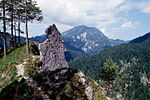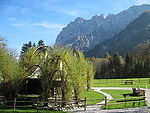Ausztria nemzeti parkjai
Of the seven national parks, four are protecting Austrian Alpine regions and three are covering waters. The largest park by far is Hohe Tauern; at 1856 négyzekilotméter (459 000 acre), it is also the largest national park in Central Europe. The Neusiedler See–Seewinkel and Thayatal national parks stretch across the border with Hungary and the Czech Republic respectively.
| Name | Photo | Location | Date established | Area | Description |
|---|---|---|---|---|---|
| Hohe Tauern | 
|
Salzburg, Tyrol, Carinthia é. sz. 47,066667°, k. h. 12,666667° |
1981 (Carinthia) 1984 (Salzburg) 1992 (Tyrol) |
1856 négyzekilotméter (458 627,6 acre) | Covering large parts of the East Alpine crest between the sources of the Möll, Mur and Salzach rivers, stretching about 100 kilométer (62 mi) from east to west and about 40 kilométer (25 mi) from north to south. The park features extended glacier fields, glacial valleys and large alluvial fans, as well as Alpine pastures and extensive larch, spruce and pine forests. |
| Nock Mountains | 
|
Carinthia é. sz. 46,883333°, k. h. 13,666667° |
1987 | 184 négyzekilotméter (45 467,4 acre) | Covering the Nock Mountains range of the Gurktal Alps. |
| Neusiedler See–Seewinkel | 
|
Burgenland é. sz. 47,817778°, k. h. 16,748611° |
1993 | 97 négyzekilotméter (23 969,2 acre) | Covering Lake Neusiedl, its shoreline and lakeside locations. Together with the adjacent Hungarian Fertő-Hanság National Park it forms the Fertö / Neusiedlersee Cultural Landscape, a UNESCO World Heritage Site since 2001. |
| Danube-Auen | 
|
Lower Austria, Vienna é. sz. 48,183333°, k. h. 16,716667° |
1996 | 93 négyzekilotméter (22 980,8 acre) | Stretching along the Danube from the City of Vienna (Lobau) to the mouth of the March (Morava) river near the border with Slovakia and the Dunajské luhy Protected Landscape Area; both are wetlands of international importance according to the Ramsar Convention. With a length of 38 kilométer (24 mi), the national park covers one of the largest untouched floodplains in Central Europe, accessible by the EuroVelo 6 long-distance cycling route. |
| Kalkalpen | 
|
Upper Austria é. sz. 47,790000°, k. h. 14,373611° |
1997 | 208 négyzekilotméter (51 397,9 acre) | Covering the Sengsengebirge and Reichraminger Hintergebirge ranges of the Upper Austrian Prealps. |
| Thayatal | 
|
Lower Austria é. sz. 48,85°, k. h. 15,90° |
2000 | 13 négyzekilotméter (3212,4 acre) | Centered around a meander cutoff of the Thaya river, on the border with the Czech Republic and the adjacent Podyjí National Park. The steep gneiss slopes along the river form one of Austria's most picturesque water gaps. |
| Gesäuse | 
|
Styria é. sz. 47,592222°, k. h. 14,648889° |
2002 | 111 négyzekilotméter (27 428,7 acre) | Covering the Gesäuse range of the northeastern Ennstal Alps in Upper Styria with the water gap of the Enns river. |
All of Austria's national parks meet IUCN Category II standards, with the exception of the Nock Mountains National Park, which had been classified as a Protected Landscape (Category V). In 2012, it was converted into the core zone of a UNESCO Biosphere Reserve.
